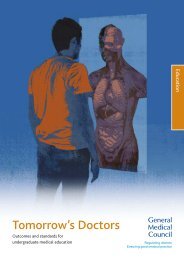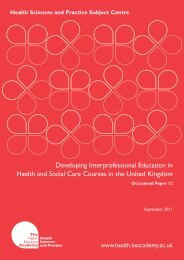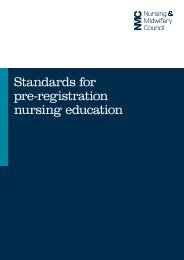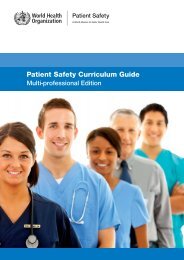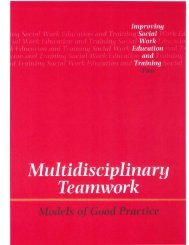Health and Social Care Policy and the Interprofessional ... - CAIPE
Health and Social Care Policy and the Interprofessional ... - CAIPE
Health and Social Care Policy and the Interprofessional ... - CAIPE
Create successful ePaper yourself
Turn your PDF publications into a flip-book with our unique Google optimized e-Paper software.
previous practices where professionals worked in isolation. 'Making a<br />
Difference' (DH, 1999a) <strong>and</strong> 'The NHS Plan' (DH, 2000a) promoted multidisciplinary<br />
<strong>and</strong> interprofessional working across areas of health <strong>and</strong> social<br />
care <strong>and</strong> emphasised that <strong>the</strong> approach to <strong>the</strong> educational preparation of<br />
future health professionals should be integrated <strong>and</strong> patient centred.<br />
A consultation document ‘A <strong>Health</strong> Service of all <strong>the</strong> Talents: Developing <strong>the</strong><br />
NHS Workforce’ recommended a complete overhaul of workforce planning<br />
(DH, 2000b). New models of service delivery were identified, each of which<br />
depended on individual professions being prepared to move out of <strong>the</strong>ir silos<br />
<strong>and</strong> work across professional <strong>and</strong> organisational boundaries. To ensure that<br />
<strong>the</strong> workforce is fully equipped for <strong>the</strong>ir new roles, <strong>and</strong> acquire <strong>the</strong> skills <strong>the</strong>se<br />
would require, a complete overhaul of <strong>the</strong>ir education <strong>and</strong> training would be<br />
necessary <strong>and</strong> <strong>the</strong>re is an explicit acknowledgement that it is vital to engage<br />
<strong>the</strong> Regulatory Bodies <strong>and</strong> <strong>the</strong> trade unions.<br />
The Government’s modernisation programme is having a profound impact on<br />
not only <strong>the</strong> NHS but also agencies such as local government <strong>and</strong> social<br />
services. <strong>Policy</strong> changes outlining increased interagency, interprofessional<br />
care can be identified within The Local Government Act 1999; The White<br />
Paper ‘Modernising <strong>Social</strong> Services’ (DH, 1998d); The White Paper<br />
‘Modernising Mental <strong>Health</strong> Services’ (DH, 1998e); The Green Paper ‘Our<br />
<strong>Health</strong>ier Nation’ (DH, 1998c); ‘Modernising <strong>Health</strong> <strong>and</strong> <strong>Social</strong> Services:<br />
National Priorities Guidance 2000/2001, 2002/2003’ (DH, 1999b); ‘The <strong>Health</strong><br />
Act 1999’ <strong>and</strong> its accompanying discussion document ‘Partnership in Action’<br />
(DH, 1998b); ‘The Crime <strong>and</strong> Disorder Act 1998’; <strong>and</strong> <strong>the</strong> ‘Quality Protects’<br />
initiative by DfES. Each of <strong>the</strong>se focuses on <strong>the</strong> need to extend strategic<br />
alliances.<br />
Moreover, <strong>the</strong> National Institute for <strong>Health</strong> <strong>and</strong> Clinical Excellence (NICE) is<br />
an independent organisation that publishes guidance in public health, health<br />
technologies <strong>and</strong> clinical practice. The <strong>Health</strong> Development Agency merged<br />
with NICE in 2005. NICE guidelines implicitly recognise a flexible workforce<br />
<strong>and</strong> also promote <strong>and</strong> reinforce partnership working (http://www.nice.org.uk/).<br />
A major issue that arises time <strong>and</strong> time again in Government publications is<br />
<strong>the</strong> continuing reluctance to use terminology that leaves <strong>the</strong> reader in doubt<br />
that <strong>the</strong>re is a m<strong>and</strong>ate to implement policy. Even in White Papers, which by<br />
definition are comm<strong>and</strong>s, words such as ‘may’, ‘might’ or ‘could’ ra<strong>the</strong>r than<br />
‘must’ or ‘should’ are used. This in effect, gives <strong>the</strong> reader an opportunity to<br />
opt out if a particular directive does not suit. Particularly good examples of<br />
this relate to ‘The Disability Discrimination Act’ (1995) <strong>and</strong> ‘The Human Rights<br />
Act’ (1998). The White Paper ‘Our <strong>Health</strong>ier Nation’ (DH, 1998c) observes for<br />
example ‘we need to encourage different professional groups to learn<br />
toge<strong>the</strong>r <strong>and</strong> to think about how we plan our workforce to meet <strong>the</strong> challenges<br />
we face’. If only <strong>the</strong> word ‘must’ had been inserted ra<strong>the</strong>r than <strong>the</strong> much less<br />
emphatic ‘think about’ planning <strong>the</strong> workforce, much more progress would<br />
have been made towards delivering a service that patients want <strong>and</strong> need. In<br />
<strong>the</strong> same year ano<strong>the</strong>r White Paper ‘Modernising <strong>Social</strong> Services’ suggested<br />
32




